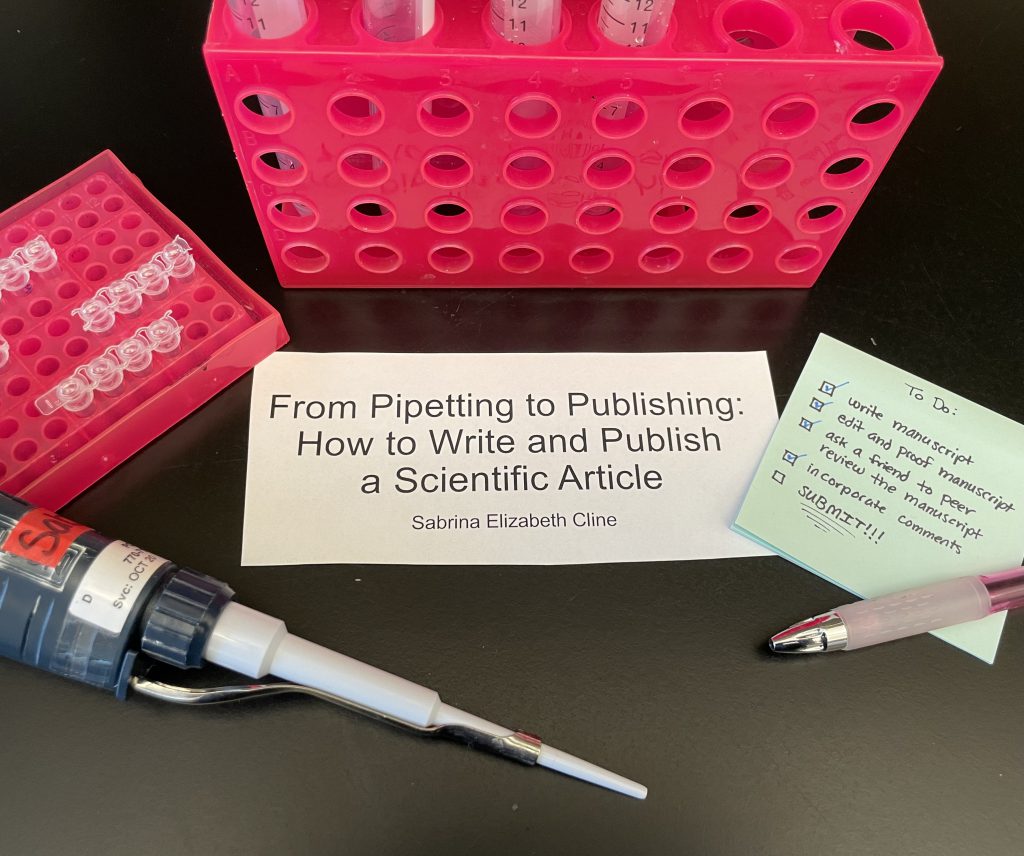From Pipetting to Publishing: How to Write and Publish a Scientific Article
by Sabrina Elizabeth Cline

Entering the world of scientific writing can be a daunting experience. The task of crafting an experimental narrative in a concise, technically correct manner with a myriad of supporting sources can be even more so. It seems that every scientific article follows a set standard and does not allow for much stylistic creativity – a drastic change from previous academic and literary writing experiences that emphasized originality and exploration. However, the creativity of scientific writing comes from the explanation behind those meticulously crafted experiments and the careful interpretation of results that led to the publishable new discovery. This shift in writing perspective is imperative because the focus of a scientific manuscript is not solely in proving the point: the published article serves as breaking news to the scientific community and a standard for experimental repeatability as well as providing evidence to support or disprove hypotheses.
The transition from experimentation to writing to publishing can be difficult. Some scientists may have not developed strong writing skills or may have a distaste for writing and hoped to find refuge in science in an attempt to avoid it. Unfortunately, to be at the forefront of scientific discovery, scientists must employ writing to create ingenious, factual narratives to win grant funding and publish high-impact scientific articles. Before delving into the scientific publishing process itself, I wanted to share five writing tips that I have learned as a scientific author and a managing editor of sciences at The Classic Journal.
Follow the journal’s submission guidelines.
Before beginning any manuscript, it is imperative to look at the submission guidelines set forward by the journal. For example, manuscripts submitted to Cell Research must have a character count under 45,000 (approximately 20,000 words)and discuss key advances in a high-interest research topic1; whereas, submissions to Nature Research must be between 2000–2500 words2 and must fulfill three criteria categories for publication.3 Each manuscript submission must adhere to the specific set of instructions to even be considered for review for publication. If these guidelines are not followed, the manuscript will automatically be rejected without being read. So, like reading the instructions before starting an important exam, read and follow the guidelines for submission before starting to write.
Create a logical flow of information.
It is important to set readers up to understand the manuscript and not immediately overwhelm them with an onslaught of information and results (i.e., immediately starting Lewis Carroll’s Alice’s Adventures in Wonderland at “Off with their heads!” or Shakespeare’s Macbeth with the titular character’s death).4,5 Such a haphazard introduction to key information would confuse the reader and could lead to misinterpretation of the manuscript’s results. Therefore, it is important to create a logical flow in the manuscript—starting with the hypothesis and supporting background information leading into the experiments and concluding with results and discussions. Like literary themes in novels and plays, each section of the scientific manuscript should be tied back to the overarching hypothesis and provide the reader with a deeper understanding of the topic.
Own the evidence.
Technicalities of intellectual property ownership and the fine details of grant funding aside, when writing any manuscript, present the facts with authority. This advance in research was completed by the manuscript’s author(s). Therefore, no one knows more about this niche, groundbreaking topic at this point in time. So when writing the first draft of the manuscript, keep this knowledge in mind: use strong verbiage, keep points clear and concise, and let that hardworking research shine.
Be consistent.
Maintaining consistency is key for increasing overall readability. While the article’s topic may be difficult to understand, readers (and editors) appreciate it when authors are consistent throughout their manuscripts. A few ways to achieve this would be keeping the same style of voice with multiple authors, repeated and straightforward abbreviations, and uniform figure formatting. When authors become inconsistent, it makes a challenging paper more difficult to understand, and it may lose the reader altogether. So, before submitting a paper, have a trusted peer review it to identify any obvious inconsistencies.
Simplify.
While it may be tempting to delve headfirst into explaining every single detail of each experiment or easy to accidentally lapse into a history lesson while connecting the narrative with every supporting citation, it is important to remember the core focus of the manuscript. Be ready to cut unnecessary details from the manuscript; if the reader has a question, they can refer to the cited sources or contact the author(s) directly. Additionally, scientific articles are not only meant for one particular subset of the scientific community; they are meant to be read and understood by the general population and global scientific community. While certain topics need more introduction than others, all readers should be able to grasp a basic understanding of the hypotheses, methods, and results without being muddled by unnecessary background information and jargon. Simplify the terminology. Introduce varying sentence structures and lengths to keep readers engaged. Reword colloquial phrases and comparisons to be universally understood. Be clear and concise with the focus of the manuscript. Highlight the key discoveries throughout the piece. Taking the time to simplify the manuscript allows for enhanced readability and allows the piece to impact a broader audience.
Finishing a manuscript can be a euphoric experience. The constant weight of perfectly expressing experimental results on paper is finally complete and never to be touched again. Except, it is not done.
After the initial manuscript is completed and submitted to a journal, it will undergo a blind peer-review process by a panel of subject experts. These reviewers will not only critique the manuscript’s writing but also the experimental procedures and result analyses. Once they have reviewed the manuscript, the panel will send back a detailed list of suggestions—ranging from recommending more citations in the introduction of the manuscript to requesting biological replicates to requiring additional experiments to be conducted to rule out experimental artifacts. These suggestions must be considered and then responded to in a cover letter as the next step of the publication process. After resubmitting the manuscript with these changes, the reviewers and editors will look again at the manuscript before deciding whether to accept the manuscript for publication. Once it is accepted, congratulations—it goes to the copy editors to be edited for any grammatical mistakes. After completing copy editing and receiving the final stamp of editorial approval, the manuscript will (finally) be published!

The process of translating the simple act of pipetting DNA into an agarose gel to obtaining a scientific publication can be a long, sometimes tedious journey. Publishing a scientific article requires more than just the completion of experiments; it is the culmination of writing, reviewing, revising, and perfecting the manuscript until it is ready for publication. Nothing truly compares to the emotion experienced when seeing hours of research and writing get published in a journal—I guarantee it. I hope to see your manuscript submissions to The Classic Journal soon!
Citations
1 “Cell Article Types,” Cell, accessed January 5, 2021, https://www.cell.com/cell/article-types
2 “Formatting Guide,” Nature, accessed January 5, 2021, https://www.nature.com/nature/for-authors/formatting-guide
3 “Editorial Criteria and Processes,” Nature, accessed January 5, 2021, https://www.nature.com/nature/for-authors/editorial-criteria-and-processes
4 Carroll, Lewis. Alice’s Adventures in Wonderland and Through the Looking Glass. Penguin Classics, 2012.
5 Shakespeare, William. Macbeth. Penguin Classics, 2000.
Sabrina Elizabeth Cline is a second-year graduate student in the Department of Cellular Biology at the University of Georgia. Her research in the Docampo Laboratory focuses on the elucidation of a protein in the inositol pyrophosphate pathway of Trypanosoma cruzi. During her undergraduate studies, she published a scientific article which unveiled RNA as a druggable target for small molecule therapeutics (DOI: 10.1016/j.bmc.2019.03.057). She formerly served as the Business Manager of Seed Literary Magazine for two years.